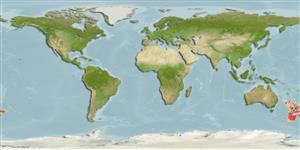Common names from other countries
Ολοκέφαλοι (χίμαιρες) (chimaeras) >
Chimaeriformes (Chimaeras) >
Chimaeridae (Shortnose chimaeras or ratfishes)
Etymology: Hydrolagus: hydro-, combining form of hydor (Gr.), water; lagos (Gr.), hare, i.e., “water rabbit,” probably referring to three pairs of tooth plates, which tend to protrude from the mouth like a rabbit’s incisors. (See ETYFish); bemisi: In honor of ichthyologist William E. Bemis, now at Cornell University, “longtime mentor and friend, and a leader in ichthyological research”. (See ETYFish).
Environment: milieu / climate zone / depth range / distribution range
Οικολογία
Θαλασσινό(ά) βαθύβιο(ς); εύρος βάθους 400 - 1100 m (Ref. 45044), usually 500 - 700 m (Ref. 45044). Deep-water
Southwest Pacific: New Zealand.
Μέγεθος / Βάρος / Age
Maturity: Lm ? range ? - ? cm
Max length : 112 cm TL αρσενικό/απροσδιόριστο; (Ref. 45044)
Short description
Κλείδες προσδιορισμού | Μορφολογία | Μορφομετρία
Pale brown coloration fading to white ventrally. Dorsal fin spine reaching to origin of second dorsal fin when depressed; elongated second dorsal fin not indented along its length. Horizontal and hyomandibular lateral line canals sharing a common branch. Caudal filament long and stout (Ref. 45044).
Oviparous (Ref. 205). Eggs are encased in horny shells (Ref. 205).
Life cycle and mating behavior
Maturities | Αναπαραγωγή | Spawnings | Egg(s) | Fecundities | Προνύμφες
Didier, D.A., 2002. Two new species of chimaeroid fishes from the southwestern Pacific Ocean (Holocephali, Chimaeridae). Ichthyol. Res. 49(4):299-306. (Ref. 45044)
IUCN Red List Status (Ref. 130435)
CITES (Ref. 128078)
Not Evaluated
Threat to humans
Harmless
Human uses
Εργαλεία
Special reports
Download XML
Διαδικτυακές πηγές
Estimates based on models
Preferred temperature (Ref.
115969): 5.4 - 9.5, mean 7.1 (based on 125 cells).
Phylogenetic diversity index (Ref.
82804): PD
50 = 0.5000 [Uniqueness, from 0.5 = low to 2.0 = high].
Bayesian length-weight: a=0.00380 (0.00194 - 0.00745), b=3.09 (2.91 - 3.27), in cm Total Length, based on LWR estimates for this species & (Sub)family-body (Ref.
93245).
Τροφικό Επίπεδο (Ref.
69278): 3.9 ±0.6 se; based on size and trophs of closest relatives
Ελαστικότητα (Ref.
120179): Χαμηλό, ελάχιστος χρόνος για διπλασιασμό πληθυσμού 4,5 - 14 έτη (Assuming Fec <100).
Fishing Vulnerability (Ref.
59153): High to very high vulnerability (67 of 100).
